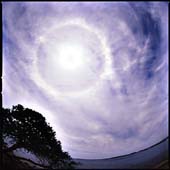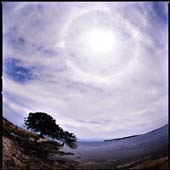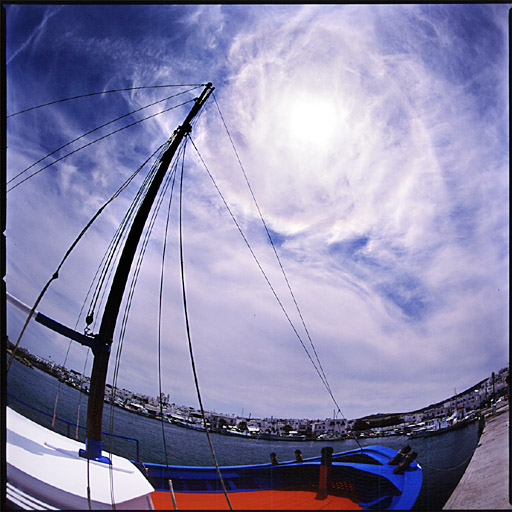 Filizi, ~11:50 am, solar alt. 63 deg
Filizi, ~11:50 am, solar alt. 63 deg
This is not a particularly remarkable halo but I include it because it gives a good idea of the geometry of the Hasselblad 30mm fisheye lens which has a diagonal field of view of 180 degrees. I also include some notes about the varying visibility of a parhelion whilst flying through cirrus with alternating turbulent and calm air.
Photographs taken on Fuji RHP transparency film with a Hassleblad and 30mm Distagon 'fisheye' lens, having a FOV 112 deg (180 deg diagonal). The original scans have been unsharp masked to enhance the faint details. The lens was used with an internal polarizing filter set to transmit a vertical E-vector. This lens has remarkably low ghosting - partly due to the steep curvature of the front elements and partly to the good antireflection coating - and so enables pictures to be taken with the Sun within the FOV.
The halo itself is not particularly remarkable but the pictures illustrate the use of this lens for wide angle images of the sky.
Click on the pictures for higher resolution (512 x 512) versions.
 Filizi, ~11:50 am, solar alt. 63 deg
Filizi, ~11:50 am, solar alt. 63 deg
 Filizi, ~11:50 am, solar alt. 63 deg
Filizi, ~11:50 am, solar alt. 63 deg
 Naoussa, ~12:15 pm, solar alt. 66 deg
Naoussa, ~12:15 pm, solar alt. 66 deg
During the plane trip from Athens to Munich on 12 May over Hungary or Austria, I noticed an interesting halo phenomenon. We were flying approximately west late in the day and I could see the right parhelion for more than half an hour as we travelled though pretty mixed flavours of cirrus at 28,000 ft. For a large fraction of the time the parhelion and a ~20deg segment of the 22 degree halo were sharp and strongly coloured with a brilliant red inner edge and a marked rich blue outer edge - presumably implying large stable crystals with little effect of diffraction. During rare turbulent patches, however, it was obvious that the halo became fuzzy with washed-out colours. Is this an understood phenomenon? It could be due either to a larger angular dispersion driven by the rougher air or due to a smaller crystal size distribution.
Go to Bob Fosbury's homepage